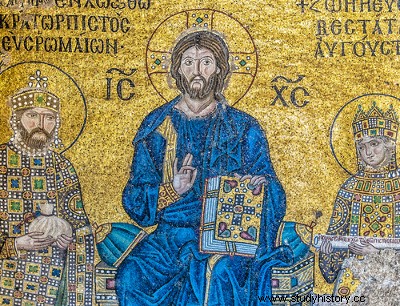
By Me. Claudius Fernandes
TheByzantine Empire left as legacy cultural great works, especially mosaics and architectural constructions. These works had as their main source, in addition to the Roman culture - considering that the Byzantine Empire was considered the Eastern Roman Empire - and the properly eastern cultures, such as Hellenism (Greek culture) of the region of Anatolia (where today the present-day Turkey), early Christianity.
Within Byzantine culture, painting and sculpture had an important but limited development. This is because of iconoclasty or motion iconoclast . In the reign of Leo III, in the 8th century, the cult of images of saints, represented in icons in paintings and sculptures, was officially condemned. This act sparked a major rebellion that took on the proportions of civil war in the city of Constantinople , capital of the Empire. Below we can read an account of the proceedings triggered by the iconoclastic edict published by Leo III:
“[…] the emperor compelled all the inhabitants of Constantinople, by force and persuasion, to displace the images of the Saviour, as well as those of his holy mother and of all saints, wherever they were, and, what is horrible to count, and burning them by fire in the midst of the city, as well as whitewashing (filling with lime) all the painted churches. Because many of the people of the city refused the burden of such an enormity, they were subjected to punishment; some were beheaded, others mutilated.” (Anastasii Bibliothecarii. Historia de Vitis Romanorum Pontificum – S. Gregorius II. In:ESPINOSA, Fernanda (org.). Anthology of historical and medieval texts. Lisbon:Sá da Costa, 1981. p. 60-61.)
Iconoclasm was only revised and condemned at the Second Council of Nicaea in 787 AD. Despite the depredation of most of the Byzantine sacred images, it is possible to verify in those that remained the main characteristics. Usually the paintings were made with the technique of fresco, representing the human forms frontally, with clear postures of mercy and piety. For this purpose, for example, the hands were always painted with symmetry of the fingers – the fingers were represented in the same size to convey the idea of cry and penance.
In addition to the painted images, the mosaics stood out immensely in the Byzantine culture, becoming, alongside architecture, the high point of the artistic expression of that culture. The Church Hagia Sophia (Hagia Sophia), located in Istanbul (formerly Constantinople), is an example of grandiose Byzantine architecture. Not to mention the stained glass art applied inside the church, which is one of the most impressive in the world.
*Image Credit: Shutterstock and Antony McAulay
